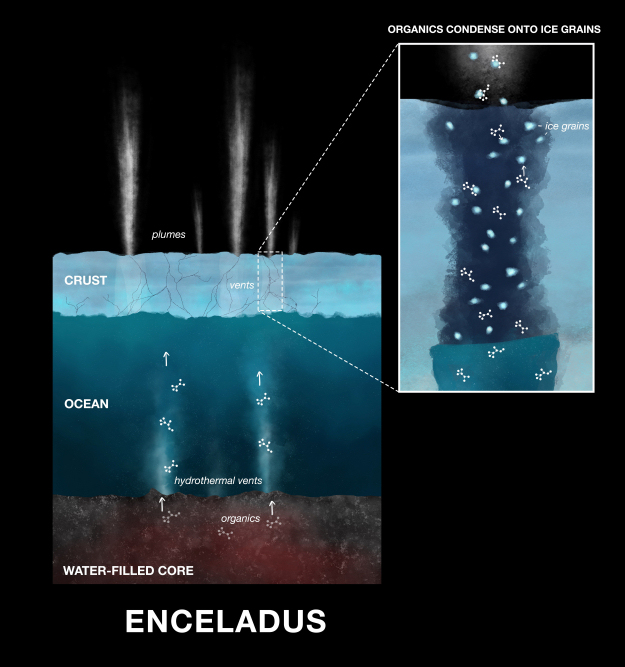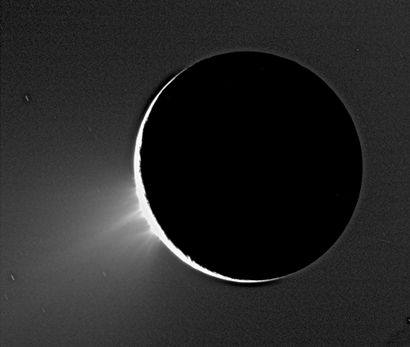Cassini finds soluble organic compounds in ocean-world Enceladus
2 October 2019
Scientists analysing archival data from the international Cassini mission have found evidence of light, soluble and reactive organic molecules in the ice grains ejected by Saturn's icy moon Enceladus. The study indicates that this moon's underground ocean contains the precursors of complex organic compounds like amino acids – the building blocks of life as we know it on Earth. |
| Organic compounds in Enceladus ice grains. Credit: NASA/JPL-Caltech |
Enshrouded in a thick icy crust, Saturn's moon Enceladus conceals a massive sub-surface ocean, given away by the erupting plumes of water vapour and ice grains that were detected by Cassini shortly after the spacecraft's arrival at the Saturn system one and a half decades ago.
Further data collected over the years by the mission suggest the plumes are directly linked to the moon's underground ocean. Evidence for hydrothermal vents on the seabed, mixing up material from the moon's water-filled, porous core with the ocean water, has also raised the tantalising question of whether Enceladus' sub-surface environment may have the right conditions for life.
Last year, a study of Cassini data led by Frank Postberg and Nozair Khawaja identified, for the first time, large complex organic molecules in the ice grains released by the plumes, strengthening the idea that this ocean-world hosts conditions suitable for biological activity.
New research conducted by the same scientists, now based at Freie Universität Berlin, Germany, has spotted additional, lighter organic compounds in the ice grains, providing another important piece of evidence to investigate the potential habitability of Saturn's iconic moon.
"In our recent analysis of the Enceladus plumes, we have found organic compounds that, on Earth, are known to be precursor species that take part in hydrothermal vent reactions and may eventually lead to the synthesis of biologically-relevant organic molecules, like amino acids," explained Nozair Khawaja, lead author of the paper reporting the results, published in Monthly Notices of the Royal Astronomical Society.
 |
| Sunlight scattering through Enceladus's water plumes. Credits: NASA/JPL/Space Science Institute. |
The team found specific nitrogen- and oxygen-bearing compounds known as amines and carbonyls, as well as compounds carrying ring-shaped molecular structures – the so-called aromatic compounds.
"These are low-mass organic molecules that were originally dissolved in Enceladus' ocean, as opposed to our previous detection of macromolecular, solid organic compounds that were likely floating on the ocean surface," he added.
Khawaja and collaborators looked at data from the Cosmic Dust Analyzer (CDA) on Cassini, which detected ice grains released from the depths of Enceladus into one of Saturn's rings – the E ring. They compared the analysis with laboratory measurements of different mixtures of water and organic material, as well as with observation from another mission's instrument, the Ion and Neutral Mass Spectrometer (INMS).
Complex, insoluble organic molecules as well as very simple ones had been previously found in the ice grains and plume gases at Enceladus, but this is the first robust detection of volatile, soluble and reactive organic species.
Most of the organic compounds identified in this study were initially in a solution within Enceladus' underground ocean, which later evaporated and condensed onto ice grains. The grains then made their way through fractures in the moon's icy crust, eventually being released into space via the plume and ending up in Saturn's E ring.
The presence of small and soluble organic compounds in Enceladus' ocean suggests that there may be even more organic compounds dissolved there.
"This work shows that Enceladus' ocean has reactive building blocks in abundance, and it's another green light in the investigation of the habitability of Enceladus," said co-author Frank Postberg.
"The new evidence points to the existence of hydrothermal activity in the warm depths of the Enceladus' subsurface ocean, not dissimilar from that found in Earth's 'Lost City' – a system of hydrothermal vents on the floor of the Atlantic Ocean, where life survives even in the absence of sunlight," added Khawaja.
Once thought inhospitable to life, the outer Solar System hosts several ocean-worlds with sub-surface liquid water like Enceladus, where hydrothermal vent reactions, paired with the right molecules, could give rise to biologically relevant compounds.
"Cassini has forever changed our understanding of potentially habitable environments," said Nicolas Altobelli, ESA Cassini project scientist.
"The fascinating questions about the habitability of ocean-worlds will be explored in greater detail in coming decades by space missions, including NASA's Europa Clipper and ESA's JUICE."
Planned for launch in 2022, JUICE will arrive at Jupiter in 2029 to investigate the giant planet's icy moons, their underground oceans and their potential for life.
Notes for editors
"Low mass nitrogen-, oxygen-bearing and aromatic compounds in Enceladean ice grains" by N. Khawaja et al. is published in Monthly Notices of the Royal Astronomical Society.
The Cassini-Huygens mission is a cooperative project of NASA, ESA and the Italian Space Agency.
For further information, please contact:
Nozair Khawaja
Freie Universität Berlin, Germany
Email: nozair.khawaja![]() fu-berlin.de
fu-berlin.de
Frank Postberg
Freie Universität Berlin, Germany
Email: frank.postberg![]() fu-berlin.de
fu-berlin.de
Nicolas Altobelli
ESA Cassini-Huygens Project Scientist
Tel: +34 91 813 1201
Email: nicolas.altobelli![]() esa.int
esa.int


